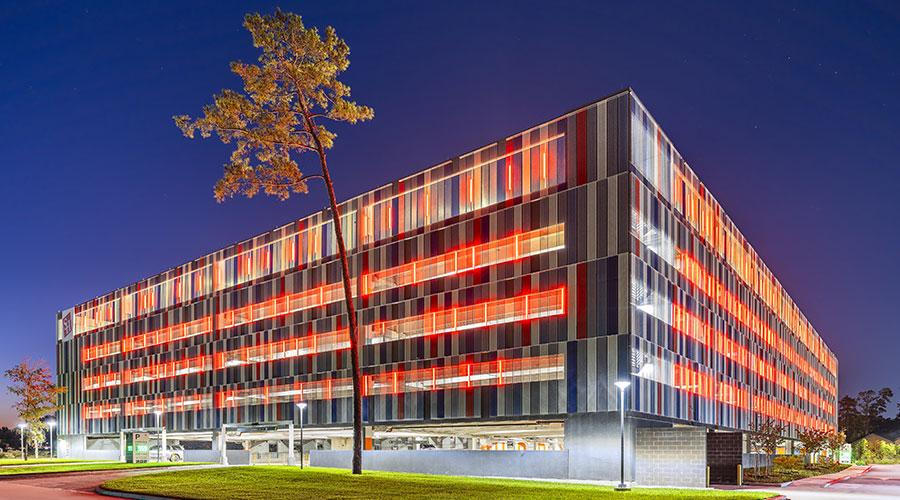Group Relamping: All Together Now
Replacing all lamps in a space at the same time, even though most haven’t burned out, often provides multiple benefits
At many facilities, when a lamp burns out, all the following steps are taken as part of spot relamping. A technician determines the lamp type, possibly by a visit to the site, gets a lamp, carries a ladder to the site, opens the fixture, replaces the lamps and then arranges for disposal.
The entire process may well distract employees near the lamp. And without close oversight, the last step is often truncated by simply dropping the lamps into the nearest dumpster where they are quickly covered — and probably smashed — by other trash, releasing their mercury. The labor involved in this process may be a significant hidden cost, especially when compared to alternatives.
Most lamp manufacturers and lighting maintenance firms recommend changing lamps before they burn out, with good reason. While perhaps a bit counterintuitive, doing so greatly reduces labor wasted on spot relamping, reduces workplace disruption and better controls lamp disposal. Lamps are replaced en masse (usually during off hours) as they approach about 60 to 70 percent of their rated lives, which is when roughly 10 percent may have burned out and before failure rates begin to climb.
For some types of high intensity discharge (HID) lamps, significant color change may occur prior to burnout. If color or color rendering are important, early replacement may also help maintain lighting quality.
Such group relamping is often done by crews whose main focus and experience is time-efficient fixture maintenance because they are paid on a piece rate basis. Trained in proper lamp disposal, they take responsibility for off-siting and documenting removed lamps.
Group relamping that follows a written work specification will also ensure the following worthwhile tasks are performed:
- Check for broken or damaged lampholders. One reason for lighting failure often missed during spot relamping is a cracked lampholder or socket that could lead to a smoking fixture if a short circuit results.
- Replace failed ballasts. Spot relampers may not be equipped or have access to inventory for replacing failed ballasts.
- Follow up on ballast and lamp warranties. Most lighting maintenance firms routinely handle such paperwork.
- Reduce on-site lamp and ballast inventories. Lighting maintenance firms maintain their own stock of lamps and ballasts, obviating the need for a customer to maintain more than odd lamps used in only a few fixtures.
- Recycle lamps. Many facilities seeking LEED points or other green status may wish to hand this task over to a firm that knows the most economical and acceptable ways to meet requirements.
- Secure available incentives. Some lamp manufacturers occasionally offer rebates or discounts, while a few states offer incentives for cutting wattage, which may be available when switching to low-power lamps during group relamping.
- Set up and maintain a lamp/ballast database. Knowing the location, specifications and last installation date of every lamp and ballast goes a long way to cutting down occasional spot relamping time, while greatly helping future upgrades.
- Handle difficult locations. Professionals may be better equipped for high bay or difficult access areas, such as atria or over operating equipment.
How Often?
While lamp lives vary, group relamping cycles for linear fluorescent lamps are often spaced about four to five years apart. That calculation is based on a typical 20,000-hour-lamp lifetime which is when (by definition) 50 percent of lamps will have burned out. At 70 percent of that time, for example, and 3,000 annual burn hours, a cycle of 4.7 years can be derived. Group relamping may be sequenced floor-by-floor, or done for an entire building, as desired to accommodate operations, crew size, etc. Lamps are gathered and disposed of in large groups, simplifying compliance with environmental regulations — which, for mercury, are becoming tighter. Since lifetimes for HID and compact fluorescent lamps (CFLs) differ from linear fluorescents, adjustments in that calculation are necessary.
In the past, replacing lamps prior to burnout was also recommended to avoid the normal drop in light levels due to lumen depreciation as lamp output diminished and dirt depreciation as fixture and lamp surfaces degraded. While that’s still valid, several changes have occurred in the last decade that may affect group relamping cycles and costs:
- A major reduction in workplace smoking eliminated the airborne tar that holds dirt.
- Better air quality and filters have made many non-industrial work places cleaner.
- Newer fluorescent lamps maintain their output better than their predecessors.
Studies by the International Association of Lighting Maintenance Companies (NALMCo) during the last decade found that, in non-industrial spaces, a lower dirt depreciation factor could be used in designing or upgrading lighting systems. In carefully controlled tests performed over many months, NALMCo determined light losses due to dirt. As seen in the box on this page, prior dirt depreciation curves for lensed and louvered fluorescent fixtures involved light losses of about 22 percent and 30 percent by the time a group relamping would be performed. (See bottom two curves in box.)
Ensuring acceptable light levels between fixture cleanings then meant installing additional fixtures, raising installation costs and boosting energy costs. New findings (see the top curve in box) for both types of fixtures indicate loss levels of about 12 percent, thus opening the door to less frequent cleaning or switching to low-power lamps or ballasts in existing fixtures.
While the fact that fixtures are staying cleaner is not a good reason to avoid cleaning them, it may indicate that fixture washing — often a task included in group relamping — may not be needed as often. Some maintenance firms instead perform a simple wipe down of fixture reflectors using an anti-static cloth when changing lamps.
Better Lamps, Better Output
In the past, one of the major reasons for early relamping was that fluorescent lamp lumen output dropped significantly over time — more than 20 percent by 70 percent of rated life for T12s. Because such a drop in output could affect productivity, sales and safety (each of which is worth a lot more than lamps), it always makes sense to maintain light levels.
Some new lamp types (e.g., T5s, some T8s, better CFLs), however, now hold their output much higher (losing about 10 percent or less of their output at 70 percent rated life). Some premium versions boast even better lumen maintenance and exceptionally long life (e.g., 30,000 instead of 20,000 hours). Some of these factors may also reduce the demand for occasional spot relamping in critical areas (e.g., executive offices, medical spaces). As a result, facility executives may wish to weigh the option of improving their lamp purchasing specs as part of their lighting maintenance efforts.
Sharpen That Pencil
When considering a group relamping contract or internal project, a facility’s mix of lamp types and their characteristics are important parameters for calculating the right relamping cycle period. Many lighting maintenance contractors will, in their proposals, provide an economic analysis to compare existing spot relamping efforts with group relamping in order to show dollar savings on labor and disposal. When making such comparisons, it pays to look closely at the numbers. Here are a few tips that may yield more realistic results.
- Use a lighting maintenance specification that all bidders must agree to follow. That will help compare apples to apples. Include lamp specs (e.g., color temperature, color rendering index, etc.), acceptable cleaning methods, preferred work hours, etc. A very good resource to that end is RP-36-03 “Recommended Practice for Planned Indoor Lighting Maintenance” ($45, $31.50 to IES members), a 34-page IES/NALMCo handbook on the subject available at www.techstreet.com/lists/light_stds_101402.tmpl.
- Take into account how lights are controlled and ballasted. The standard 20,000-hour T12 lifetime assumes, for example, three-hour on-off cycles but many facilities have much longer on-off cycles (e.g., 10 hours a day) which could stretch out average lamp life, which is affected by the frequency of switching. On the other hand, lamps controlled by occupancy sensors could have much shorter on-off cycle times but fewer annual burn hours. Depending on such on-off cycling, instant start ballasts may hasten lamp burnout, while use of programmed-start ballasts may help extend lamp life.
- Where electricity costs many times the combined cost of labor and lamps, be sure to pay attention to the avoided cost of power while lamps are burned out. This is often left out of calculations. In areas where some burnouts can be tolerated for several months, a slight loss in light level may not affect productivity or sales, but would yield temporary energy cost savings. Be sure, however, that leaving a burned out lamp does not compromise ballast life. Review ballast specifications or call the manufacturer for details.
- If in-house personnel that previously performed spot relamping remain employed, ensure that claimed labor savings will actually occur. If spot relamping was always done on overtime, for example, that extra cost would be avoided. But if such personnel performed spot relamping during their normal work day and are now simply shifted to other tasks, the bottom line may not show actual labor cost savings.
To find a qualified lighting maintenance contractor, look for firms that are members of NALMCo. Such firms seek to maintain a higher level of service and typically have personnel holding NALMCo’s Certified Lighting Maintenance Contractor (CLMC) standing.
OPPORTUNITIES
Firms Offer a Menu of Services
Lighting maintenance firms do a lot more than group relamping. Many also perform additional services that can reduce costs or improve lighting quality, including:
- Assisting with or pursuing energy upgrades. Due to improvements in lighting technology, significant savings may be available even where lighting was upgraded only 10 years ago. Lighting maintenance firms may be able to recommend such upgrades and perform no-cost analyses to assess payback.
- Re-commissioning lighting control systems. As controls become more sophisticated, getting the most out of them may require an occasional tune-up, especially where facilities have changed operations or rearranged spaces.
- Installing and adjusting occupancy sensors. Many facility personnel find motion sensing technologies too difficult to locate and adjust properly; experienced professionals may be just the ticket to take advantage of this option without causing complaints or headaches.
- Improving lighting quality. While a professional lighting designer or architect may be needed to fashion a new space, a knowledgeable lighting maintenance professional can make an existing space look better by advising on lighting color and color rendering choices, as well as new lamp options.
|
Changing View of Luminaire Dirt Depreciation (LDD)
 Cleaner fixtures in non-industrial spaces have significantly reduced luminaire dirt depreciation — light losses due to dirt on fixtures. As a result, it may be possible to clean existing fixtures less often or to switch to low-power lamps or ballasts. (Reprinted from IESNA RP-36-03 with permission from the Illuminating Engineering Society of North America.) Cleaner fixtures in non-industrial spaces have significantly reduced luminaire dirt depreciation — light losses due to dirt on fixtures. As a result, it may be possible to clean existing fixtures less often or to switch to low-power lamps or ballasts. (Reprinted from IESNA RP-36-03 with permission from the Illuminating Engineering Society of North America.)
|
Lindsay Audin is president of EnergyWiz, an energy consulting firm based in Croton, N.Y. He is a contributing editor for Building Operating Management.
Related Topics:








 Cleaner fixtures in non-industrial spaces have significantly reduced luminaire dirt depreciation — light losses due to dirt on fixtures. As a result, it may be possible to clean existing fixtures less often or to switch to low-power lamps or ballasts. (Reprinted from IESNA RP-36-03 with permission from the Illuminating Engineering Society of North America.)
Cleaner fixtures in non-industrial spaces have significantly reduced luminaire dirt depreciation — light losses due to dirt on fixtures. As a result, it may be possible to clean existing fixtures less often or to switch to low-power lamps or ballasts. (Reprinted from IESNA RP-36-03 with permission from the Illuminating Engineering Society of North America.)



